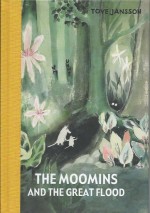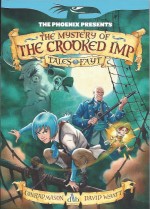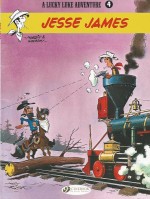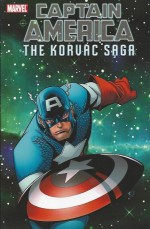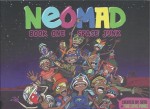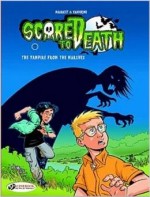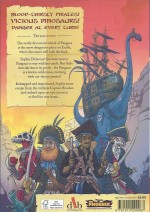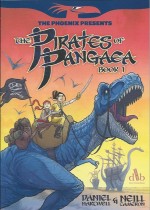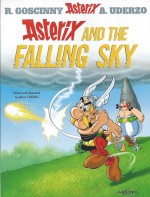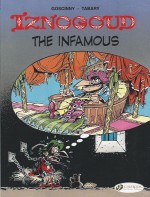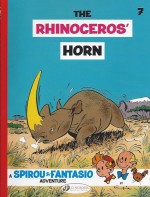
By André Franquin, translated by Jerome Saincantin (Cinebook)
ISBN: 978-1-84918-224-9
Spirou (whose name translates as both “squirrel†and “mischievous†in the Walloon language) was created by French cartoonist François Robert Velter under the pen-name Rob-Vel for Belgian publisher Éditions Dupuis in response to the phenomenal success of Hergé’s Tintin for rival outfit Casterman.
The legendary title was launched on April 21st 1938 with a rival red-headed lad as the lead of an anthology weekly comic which bears his name to this day.
The character began life as a plucky bellboy/lift operator employed by the Moustique Hotel (a reference to publisher’s premier periodical Le Moustique) whose improbable adventures with his pet squirrel Spip eventually evolved into high-flying surreal comedy dramas.
Spirou and his associates have spearheaded the magazine for most of its life, with a phalanx of truly impressive creators carrying on Velter’s work, beginning with his wife Blanche “Davine†Dumoulin who took over the strip when her husband enlisted in 1939.
She was assisted by Belgian artist Luc Lafnet until 1943 when Dupuis purchased all rights to the feature, after which comic-strip prodigy Joseph Gillain (“Jijéâ€) took the helm.
In 1946 Jijé‘s assistant André Franquin assumed the reins, gradually sidelining the short, gag-like vignettes in favour of longer epic adventure serials, introducing a wide and engaging cast of regulars and eventually creating a phenomenally popular magic animal dubbed Marsupilami to the mix (first seen in Spirou et les héritiers in 1952 and now a spin-off star of screen, plush toy store, console games and albums all his own).
He crafted increasingly fantastic tales and absorbing Spirou sagas until he resigned in 1969.
He was succeeded by Jean-Claude Fournier who updated the feature over the course of nine stirring adventures which tapped into the rebellious, relevant zeitgeist of the times with tales of environmental concern, nuclear energy, drug cartels and repressive regimes.
By the 1980s the series seemed outdated and without direction: three different creative teams alternated on the feature, until it was at last revitalised by Philippe Vandevelde – writing as Tome – and artist Jean-Richard Geurts AKA Janry, who adapted, referenced and in many ways returned to the beloved Franquin era. Their sterling efforts consequently revived the floundering feature’s fortunes and resulted in fourteen wonderful albums between 1984 and 1998.
As the strip diversified into parallel strands (Spirou’s Childhood/Little Spirou and guest-creator specials A Spirou Story By…) the team on the main vehicle were succeeded by Jean-David Morvan & José-Luis Munuera, and in 2010 Yoann & Vehlmann took over the never-ending procession of amazing adventures…
Cinebook have been publishing Spirou & Fantasio’s exploits since October 2009, mainly translating Tome & Janry’s superb pastiche/homages of Franquin, but for the fifth episode (The Marsupilami Thieves), they reached all the way back to 1952 and the second appearance of the adorable wonder-beast by the great man himself.
With that brave experiment clearly having paid dividends they repeated the experiment here, but with times and taste having changed so radically felt the need to issue a heartfelt warning and carefully considered apologia regarding some content of The Rhinoceros’ Horn…
I’ll précis it here: it was sixty years ago and our attitudes to hunting, minorities and especially the modern obscenity of killing for ivory and horn have thankfully changed. Please read this book with that in mind. The publishers, of course, phrased it much better…
André Franquin was born in Etterbeek, Belgium on January 3rd 1924. Drawing from an early age, the lad only began formal art training at École Saint-Luc in 1943. When the war forced the school to close a year later, he found animation work at Compagnie Belge d’Animation in Brussels where he met Maurice de Bevere (Lucky Luke creator “Morrisâ€), Pierre Culliford (Peyo, creator of The Smurfs) and Eddy Paape (Valhardi, Luc Orient).
In 1945 all but Peyo signed on with Dupuis, and Franquin began his career as a jobbing cartoonist and illustrator, producing covers for Le Moustique and scouting magazine Plein Jeu.
All during those early days Franquin and Morris were being tutored by Jijé who was the main illustrator at Spirou. He turned the youngsters and fellow neophyte Willy Maltaite AKA Will (Tif et Tondu, Isabelle, Le jardin des désirs) into a perfect creative bullpen known as the La bande des quatre or “Gang of Four†who revolutionised Belgian comics with their prolific and engaging “Marcinelle school†style of graphic storytelling.
Jijé handed Franquin all responsibilities for the flagship strip part-way through Spirou et la maison préfabriquée, (Spirou #427, June 20th 1946) and the lad ran with it for two decades, enlarging the scope and horizons until it became purely his own.
Almost every week fans would meet startling new characters such as comrade and rival Fantasio and crackpot inventor the Count of Champignac. Along the way Spirou and Fantasio became globe-trotting journalists, continuing their exploits in unbroken four-colour glory.
The heroes travelled to exotic places, uncovering crimes, revealing the fantastic and clashing with a coterie of exotic arch-enemies such as Zorglub and Zantafio. This particular tale saw the debut of one of the first strong, capable female characters in European comics; rival journalist Seccotine (renamed Cellophine for this translation).
In a splendid example of good practise, Franquin mentored his own band of apprentice cartoonists during the 1950s. These included Jean Roba (La Ribambelle, Boule et Bill), Jidéhem (Sophie, Starter, Gaston Lagaffe) and Greg (Bruno Brazil, Bernard Prince, Achille Talon, Zig et Puce), who all worked with him on Spirou et Fantasio.
In 1955 Рaround the time this story was collected into an album Рcontractual conflicts with Dupuis forced Franquin to sign up with rival outfit Casterman on Tintin. Here he collaborated with Ren̩ Goscinny and old pal Peyo whilst creating the raucous gag strip Modeste et Pompon.
He soon patched things up with Dupuis and returned to Spirou, subsequently co-creating Gaston Lagaffe in 1957, but was obliged to carry on his Tintin work too…
From 1959 on, writer Greg and background artist Jidéhem assisted Franquin but by 1969 the artist had reached his Spirou limit and resigned, taking his mystic Marsupilami with him…
His later creations include fantasy series Isabelle, illustration sequence Monsters and bleak adult conceptual series Id̩es Noires, but his greatest creation Рand one he retained all rights to on his departure Рis Marsupilami.
Franquin, plagued in later life by bouts of depression, passed away on January 5th 1997 but his legacy remains, a vast body of work that reshaped the landscape of European comics.
The Rhinoceros’ Horn was originally serialised in two sequences in Spirou: #764-787 (Spirou et la Turbotraction) and #788-797(La corne de rhinocéros), spanning late 1952 and early 1953 before being united in hardback album La corne de rhinocéros in 1955.
The story begins with Spirou exulting over the success of Fantasio’s latest enterprise – personal helicopters worn as backpacks – but his pal is rather down in the dumps. He’s just been dressed down by his editor on The Mosquito and warned that the paper has hired a new reporter: a real go-getting hotshot…
Dejected and desperate Fantasio determines to revive his career by staging a publicity stunt: robbing the Good Bazaar Department Store…
As the rattled reporter draws up his plans and sends a warning to the store of his intentions, a colossal explosion shakes the town. Persons unknown have blown up the nearby Turbot car plant. With even more to prove now, Fantasio proceeds…
Dragged along for the ride to photograph the stunt, Spirou and Spip reluctantly join their pal in the hare-brained venture. Landing on the roof of the emporium courtesy of the petrol-powered “Fantacoptersâ€, they deftly break in through the fire-door, Spirou recording everything with his gigantic flash camera.
Typically the lead-footed burglars make an appalling clatter and tremendous mess but no night-watchmen confront them. They’ve all been incapacitated and tied up by real robbers…
Hearing the villains approach, the lads take refuge in a wardrobe in the bedrooms department and discover an old acquaintance already there. Behring works for Turbot and was wounded in the explosion earlier. Moreover, he’s carrying blueprints for the company’s latest advancement and the burglars in the darkened store are actually bandits trying to finish him off to get them…
Handing the boys an envelope and begging them to get it to his employer Mr. Martin, the troubleshooter loses consciousness just as the nervous heroes are challenged by a shadowy figure demanding the precious prize. It’s not the bad guys however, but Fantasio’s new journalistic nemesis…
Cellophine is already streets ahead of them: she knows of the plot to steal Turbot’s revolutionary supercar. All she needs is the address Behring muttered to secure an interview with the in-hiding Martin and her next terrific scoop…
And that’s when the gun-toting bandits make their move, demanding blueprints and rendezvous address. Thankfully Spirou is still holding the camera and super-bright flashgun…
Hilariously and calamitously fleeing for their lives through the darkened store, the boys eventually make their escape via fantacopters from the top storey, allowing Cellophine to lock the bandits up on the roof before dragging Behring to safety.
The next morning the boys are in Whistleton but Martin has already fled. His note reveals nothing, but later a sinister stranger in a café advises them to surrender the blueprints and warns them not to join Martin in Bab-el-bled in North Africa.
Ignoring him and returning home, they encounter the distressingly persistent Cellophine and Spirou clues her in. Sadly the thugs have tracked them down and overhear the plans. When the boys catch a jet liner to Africa, the heavily disguised heavies are in the seats behind them…
They villains are on their tails all though the streets of Bab-el-bled, but a wig malfunction in the Souk warns Spirou they’re being followed and another hectic chase ensues.
Thinking they’ve at last shaken their pursuers our heroes go to Martin’s house only to learn he was ambushed by the bandits…
Happily the troubled Turbot exec escaped and fled further into North Africa. He’s rushing off to the M’saragba Animal Reservation but as the boys try to follow Cellophine appears and pips them to the last spot on the plane – stowed away in the baggage hold…
Forced to follow by train, it is eight days later when Fantasio and Spirou finally reach the Reserve and yet again – as the infinitely annoying Cellophine explains – they’ve just missed Martin. He was chased into the bush by the implacable bandits…
The youngsters go after him and, later that afternoon, find him just after the thugs do. Having shot Martin, the villains are smugly gloating when the sinister stranger from the café in Whistleton appears. He’s a cop and finally has enough evidence to arrest them for blowing up the factory…
They are all too late. The harassed entrepreneur has already got rid of his portion of the plans, giving them to a native friend to hide.
As Martin is carried to hospital, Spirou and Fantasio volunteer to retrieve the accursed documents but they have not reckoned on the quirky ingenuity of the chief of the Wakukus, the vastness of the reserve and the sheer bloody-mindedness of the local flora and fauna.
After days of unpleasant and painful adventures they finally locate the tribe and, following even more nerve-wracking moments convince the chief that they too are friends of Martin. That’s when the king delivers his bombshell.
Tasked with keeping safe the plans – now contained on a spool of microfilm – the wily Wakuku had his men capture a live rhino before drilling a hole in its horn and sealing the container within. He then released it back into the wild. He has no idea where it is now or even which of the 200 in the park it might be…
Determined to complete their mission, the lads spend months tracking and capturing the assorted beasts. The task becomes only slightly easier after they find a dipsomaniac white trader who sells them hunting gear and latterly, yellow paint so that they can tell the rhinos they’ve already checked from the ones so cunningly evading them…
It’s a backbreaking, heartbreaking and increasingly pointless task but only when their resolve crumbles and they brokenly give up and head for home do they find the prize in the very last place they looked…
Even the trip back is a tribulation, and eventually they collapse only to awake in a nice clean hospital with Martin and Cellophine offering to fill in the blanks on this baffling case…
Six weeks later the lads are recuperating at home when Behring shows up. He’s got a little reward for them from the grateful Turbot Company but, as usual, Cellophine is on hand to spoil it for Fantasio…
Stuffed with superb slapstick situations, riotous keystone kops chases and gallons of gags, this exuberant yarn is a true celebration of angst-free action, thrills and spills. Easily accessible to readers of all ages and drawn with all the beguiling style and seductively wholesome élan which makes Asterix, Lucky Luke, The Bluecoats and Iznogoud so compelling, this is another enduring comics treat from a long line of superb exploits, certain to be as much a household name as those series – and even that other kid with the white dog…
Original edition © Dupuis, 1955 by Franquin. All rights reserved. English translation 2014 © Cinebook Ltd.

